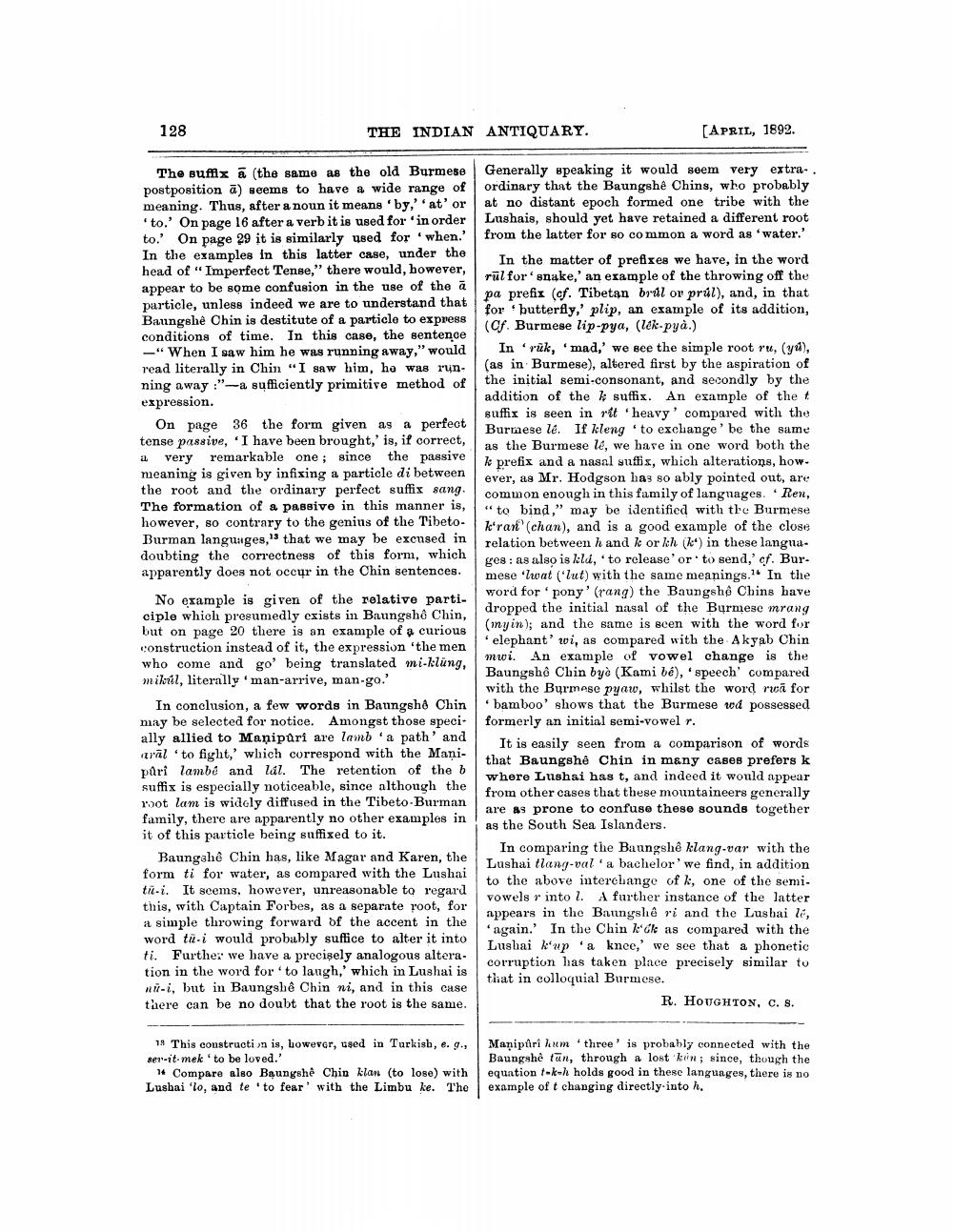________________
128
THE INDIAN ANTIQUARY.
[APRIL, 1892.
The Bufix ā (the same as the old Burmese Generally speaking it would seem very extrapostposition ā) seems to have a wide range of | ordinary that the Baungshê Chins, who probably meaning. Thus, after a noun it means 'by,'' at'or at no distant epoch formed one tribe with the 'to.' On page 16 after a verb it is used for ' in order Lushais, should yet have retained a different root to.' On page 29 it is similarly used for when.' from the latter for so common a word as 'water.' In the examples in this latter case, under the
In the matter of prefixes we have, in the word head of "Imperfect Tense," there would, however,
rül for snake,' an example of the throwing off the appear to be some confusion in the use of the ā
pa prefix (of. Tibetan brul or prúl), and, in that particle, unless indeed we are to understand that
for butterfly,' plip, an example of its addition, Baungshe Ohin is destitute of a particle to express
(Cf. Burmese lip-pya, (lék-pyà.) conditions of time. In this case, the sentence
-"When I saw him he was running away," would In 'rūk, 'mad,' we see the simple root ru, (yd), read literally in Chin "I saw him, ho was run. (as in Burmese), altered first by the aspiration of ning away :"-a sufficiently primitive method of the initial semi-consonant, and secondly by the expression.
addition of the suffix. An example of the
suffix is seen in rit heavy' compared with the On page 36 the form given as a perfect
Burmese le. If kleng 'to exchange' be the same tense passive, I have been brought,' is, if correct,
as the Burmese le, we have in one word both the a very remarkable one ; since the passive
ke prefix and a nasal suffis, which alterations, how. meaning is given by infixing a particle di between
ever, as Mr. Hodgson has so ably pointed out, are the root and the ordinary perfect suffix sang. common enough in this family of languages. Ren, The formation of a passive in this manner is,
"to bind," may be identified with the Burmese however, so contrary to the genius of the Tibeto. krart' (chan), and is a good example of the close Burman languages," that we may be excused in
relation between h and k or kh (k) in these languadoubting the correctness of this form, which
ges: as also is kld, to release' or to send,' cf. Burapparently does not occur in the Chin sentences.
mese 'Iwat ('lut) with the same meanings.1. In the No example is given of the relative parti
word for ' pony' (rang) the Baungshê Chins have ciple which presumedly exists in Baungahê Chin,
dropped the initial nasal of the Burmese mrang but on page 20 there is an example of a curious
(myin); and the same is scen with the word for construction instead of it, the expression 'the men
elephant' wi, as compared with the Akyab Chin who come and go' being translated mi-klung,
mwi. An example of vowel change is the
Baungshê Chin byè (Kami bé), speech' compared mikul, literally 'man-arrive, man-go.'
with the Burmese pyaw, whilst the word rá for In conclusion, a few words in Baungsha Chin bamboo' shows that the Burmese rod possessed may be selected for notice. Amongst those speci formerly an initial semi-vowel r. ally allied to Manipuri are lamb 'a path' and
It is easily seen from a comparison of words tral to fight,' which correspond with the Mani
that Baungshê Chin in many cases prefers k půri lambé and lul. The retention of the b
where Lushai has t, and indeed it would appear suffix is especially noticeable, since although the
from other cases that these mountaineers generally root lam is widely diffused in the Tibeto-Burman
are as prone to confuse these sounds together family, there are apparently no other examples in
as the South Sea Islanders. it of this particle being suffixed to it.
In comparing the Baungshé klang var with the Baungahê Chin has, like Magar and Karen, the
Lushai tlang-val'a bachelor'we find, in addition form ti for water, as compared with the Lushai
to the above interchange of k, one of the semi. til-i. It seems, however, unreasonable to regard this, with Captain Forbes, as a separate root, for
vowels r into l. A further instance of the latter
appears in the Baungshê ri and the Lusbai le, a simple throwing forward of the accent in the
again.' In the Chin kúk as compared with the word tu.i would probably suffice to alter it into
Lushai k up a knee,' we see that a phonetic ti. Further we have a precisely analogous altera. tion in the word for 'to laugh,' which in Lushai is
corruption has taken place precisely similar to
tliat in colloquial Burmese. -i, but in Baungshê Chin ni, and in this case there can be no doubt that the root is the same.
R. HOUGHTON, C. S.
18 This construction is, however, used in Turkish, e.g. ser-it-mek to be loved.'
1Compare also Baungshê Chin klan (to lose) with Lusbai 'lo, and te 'to fear' with the Limbu ke. The
Manipäri hum three' is probably connected with the Baungshe tun, through a lost kin; since, though the equntion t-k-h holds good in these languages, there is no example of t changing directly into h.




